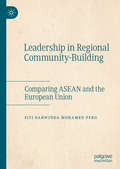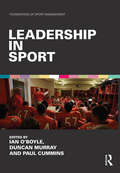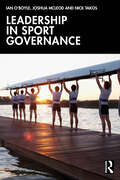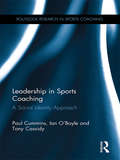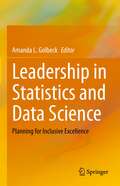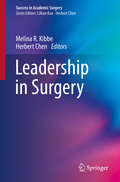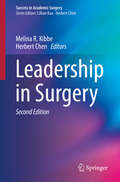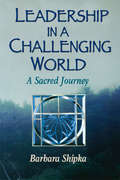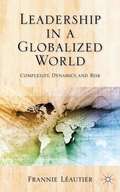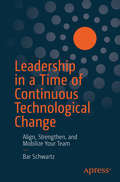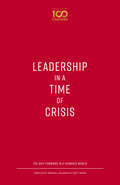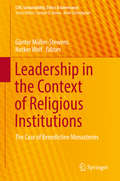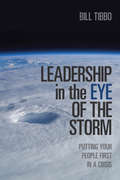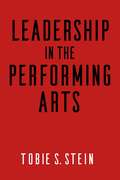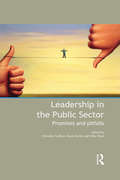- Table View
- List View
Leadership in Public and Nonprofit Organizations: An Introduction
by Montgomery Van Wart Pamela S. MedinaLeadership in Public and Nonprofit Organizations, Fourth Edition provides a compact but complete analysis of leadership for students and practitioners who work in public and nonprofit organizations. Offering a comprehensive review of leadership theories in the field, from the classic to the cutting-edge, and how they relate specifically to the public sector and nonprofit contexts, this textbook covers the major competency clusters in detail, supported by research findings as well as practical guidelines for improvement. These competencies are portrayed in a leadership action cycle that aids readers in visually connecting theory and practice. This thoroughly revised new edition also offers: Questions for discussion and analysis, hypothetical scenarios for each chapter, as well as an easily reproducible leadership assessment instrument students may use to apply the theories they’ve learned Expanded coverage of nonprofit leadership integrated throughout the chapters, including in-depth discussions about managing volunteers, fundraising ethics, the nonprofit board, advocacy, diversity and philanthropy, emotional labor, and mission-based leadership An all-new chapter section on virtual leadership approaches, designed to help current and future managers cope with the unique opportunities and challenges present by remote work Leadership in Public and Nonprofit Organizations is not only an essential core text designed specifically with upper-level and graduate public administration and nonprofit management courses on leadership in mind, but it has also proven an indispensable guidebook for professionals seeking insight into the role of successful leadership behavior in the public and nonprofit sectors. It can further be used as supplementary reading in introductory courses examining management competencies, in leadership classes to provide practical self-help and improvement models, and in organizational theory classes that wish to balance organizational perspectives with individual development.
Leadership in Regional Community-Building: Comparing ASEAN and the European Union
by Siti Darwinda Mohamed PeroThis book examines the role of political leadership as a driver in the process of regional community-building in the Association of Southeast Asian Nations (ASEAN) and the European Union (EU). It considers under which conditions political leadership constitutes a driver of regional community-building and reconceptualises the very idea of political leadership in order to examine its role in a regional context. The book concludes that a comprehensive approach that incorporates political will, the capacity of individual leaders, state capacity, legitimacy, and summitry yields a deeper understanding of political leadership in regional bodies.
Leadership in Sport (Foundations of Sport Management)
by Ian O'Boyle Duncan Murray Paul CumminsEffective leadership is essential in any sports organisation, both in the boardroom and on the training pitch. Leadership in Sport is the first textbook to examine sports leadership in the round, across both management and coaching environments. It includes a dedicated section to underpinning core leadership theories, and employs a number of case studies throughout to show how best practice is applied in real world settings. Drawing on expertise from some of the leading academics and practitioners throughout the world, and from both disciplines, the book covers various leadership issues including: facilitative leadership strategic leadership leading effective change diversity in leadership communication and empathy motivation and performance. Key conceptual questions—the nature of leadership, its role in sport, styles of leadership, what constitutes ineffective leadership—and other contemporary issues are also explored to give students and practitioners the most complete and clear picture of contemporary leadership in sport. With useful features in every chapter, such as key terms and review questions, this is an essential text for sport management or coaching degree courses.
Leadership in Sport Governance
by Ian O'Boyle Joshua McLeod Nick TakosThis is a concise introduction to leadership and governance theory and how they are applied in sport. Presenting a series of case studies from around the world, the book offers a detailed guide to best practice in the leadership of sport boards and organisations. Drawing on cutting-edge research, the book sets out the core concepts and principles of good leadership and good governance, explaining their importance in an era in which sport organisations have become increasingly bound by legal frameworks and subject to greater calls for accountability from wider society. The book analyses the key issues related to leadership in sport governance, including leadership styles with a focus on authentic leadership; intra-group dynamics; managing conflict and trust; leading in multi-layered networks; strategic leadership; and diversity, equity, and inclusion (DEI); and it considers the differing requirements of sport leadership in different geographical locations, under varying challenges and pressures. Full of illuminating cases, data and examples, this is an invaluable reading for any course in sport business and management and a useful primer for any sport business professional looking to improve their professional knowledge.
Leadership in Sports Coaching: A Social Identity Approach (Routledge Research in Sports Coaching)
by Ian O'Boyle Tony Cassidy Paul CumminsThe professionalisation of sports coaching has demanded higher standards of leadership in order to improve performance and effectiveness. This book focuses on leadership in sports coaching, exploring key concepts and principles underpinned by a presentation of new empirical research. Placing social identity theory at its centre – a theory not previously applied to sports coaching – this book provides students and researchers with a powerful tool for understanding the complex social dynamic that is the coaching process. Its chapters cover all the central aspects of sports coaching, including leadership style, measuring effectiveness, motivation, confidence and team self-esteem. Chapters explore different coaching environments to investigate the extent to which social identity impacts on coaching and leadership. A ground-breaking contribution to this field of research, this book demonstrates the significance of social identity theory in sport for athletes, coaches and leaders. Leadership in Sports Coaching: A social identity approach is an illuminating read for any student or researcher with an interest in coaching theory, coaching practice, sport psychology, sport leadership or sport management.
Leadership in Statistics and Data Science: Planning for Inclusive Excellence
by Amanda L. GolbeckThis edited collection brings together voices of the strongest thought leaders on diversity, equity and inclusion in the field of statistics and data science, with the goal of encouraging and steering the profession into the regular practice of inclusive and humanistic leadership. It provides futuristic ideas for promoting opportunities for equitable leadership, as well as tested approaches that have already been found to make a difference. It speaks to the challenges and opportunities of leading successful research collaborations and making strong connections within research teams. Curated with a vision that leadership takes a myriad of forms, and that diversity has many dimensions, this volume examines the nuances of leadership within a workplace environment and promotes storytelling and other competencies as critical elements of effective leadership. It makes the case for inclusive and humanistic leadership in statistics and data science, where there often remains a dearth of women and members of certain racial communities among the employees. Titled and non-titled leaders will benefit from the planning, evaluation, and structural tools offered within to contribute inclusive excellence in workplace climate, environment, and culture.
Leadership in Surgery
by Herbert Chen Melina R. KibbeHow does one become a successful leader? This book teaches the theories and concepts behind leadership and explains the skills and traits needed to become a good leader. Teaching surgical faculty and trainees (i. e. , residents and fellows) how to successfully lead will create more effective surgeon leaders. The skills and theories reviewed in this Volume are highly useful for numerous leadership situations, ranging from heading a committee, leading a research laboratory, directing a clinical effort, leading a Division, leading a Department, among others. By gathering these skills and theories into one comprehensive, portable book, more readers will have access to them.
Leadership in Surgery: Leadership In Surgery (Success in Academic Surgery)
by Herbert Chen Melina R. KibbeThis updated volume provides a guide to the theories and concepts of leadership in surgery. New chapters on team motivation, understanding different healthcare systems, and leadership negotiation are included. Practical management skills are also covered, including how to manage difficult personalities, change management, and conflict resolution techniques. Leadership in Surgery examines the skills and characteristics needed to be a good leader and aims to improve surgical leadership. The book is relevant to both trainees and practicing surgeons.
Leadership in War and Peace: Masculine and Feminine
by Joan Johnson-FreeseThis book offers a gendered perspective on leadership in war and peace, considering leadership in its complexity and presenting a practical examination of both leadership successes and failures.The work challenges readers to think through and discuss specific aspects of leadership, including how and why leadership diversity matters and the ethical challenges presented by the revolving door of the military–industrial complex. Further, leaders responsible for decisions involving war and peace must be able to understand, appreciate, and communicate effectively with everyone they work with and have a repertoire of leadership styles to use depending on context. The book represents an excellent tool for developing such skills, as it uniquely considers leadership through both male and female lenses, along with the experiences and perspectives of multiple military, government, and industry leaders interviewed by the author, making it both relatable and informative.This book will be of much interest to students of gender studies, leadership studies, defense studies, and military studies in general, as well as military and security practitioners.
Leadership in a Challenging World
by Barbara ShipkaLeadership in a Challenging World is about a journey to wholeness. The whole self is sacred and required in order to lead well in the complex world of today and tomorrow. Divided into 3 parts, the book begins with the metaphor of the forest for the world, with both its demanding challenges and its magnificent possibilities. Part 2 uses the metaphor of walking on a path to suggest eight subjective human powers that are essential to leading in business today and tomorrow. Finally. part 3 describes an ancient basis for the powers and shows how they can serve to bring balance to each other that results in human wholeness.
Leadership in a Diverse and Multicultural Environment: Developing Awareness, Knowledge, and Skills
by Paul B. Pedersen Dr Mary L. ConnerleyLeadership in a Diverse and Multicultural Environment provides leaders with the tools necessary to effectively interact with all individuals. Although much of the research related to multiculturalism has focused on expatriates and international assignments, the book also focuses on leaders in domestic organizations, as they can benefit from developing their own multicultural awareness, knowledge, and skills. Effective leaders can shape the culture of their organization to be accepting of individuals from all races, ethnicities, religions, and genders with a minimum of misunderstandings.
Leadership in a Globalized World: Complexity, Dynamics, and Risks
by Frannie LéautierThis book investigates key issues facing leaders in increasingly complex decision-making environments as a result of globalization. It presents a synthesis and interpretation of academic research in multiple disciplines and integrates it into a practical approach that is readily useable by leaders in government, corporations, and civil society.
Leadership in a Globalizing World
by Rosabeth Moss KanterIn this chapter, world-renowned business expert, author, and Harvard Business School professor Rosabeth Moss Kanter asks the question, "Is leadership different in a globalizing world-one of broadening horizons and burgeoning sources of ideas and supplies-than in other contexts?" The answer is a resounding yes. Kanter identifies three aspects of globalization-increased uncertainty, complexity, and diversity-that fundamentally reshape the work leaders must perform. Based on field observations of leaders in large global firms, she finds that these forces shape the context of three distinctive tasks leaders face as they guide their organizations and influence the constituencies that surround them: 1) institutional work to deal with uncertainty, 2) integrative work to deal with complexity, and 3) identity work to deal with diversity. With compelling examples of global leadership within international companies such as IBM, Cemex, Procter & Gamble, and Paris-based advertising and communications giant Publicis Groupe, Kanter builds a strong case for making these organizations and their leaders the focus of further research and study. This chapter was originally published as Chapter 20 of "Handbook of Leadership Theory and Practice: A Harvard Business School Centennial Colloquium."
Leadership in a Time of Continuous Technological Change: Align, Strengthen, and Mobilize Your Team
by Bar SchwartzDigital technology is rapidly challenging the way we do business, interact with our communities, and learn about the world. Due to this, leading change in your digital organization now comes with unprecedented tools and platforms to make your teams the most effective they can be. Leadership in a Time of Continuous Technological Change has arrived at this pivotal moment and is your roadmap for this exciting, evolving journey. Author Bar Schwartz introduces a holistic framework for leaders to take the reins in the digital Wild West. Achieving your team’s goals in this new environment will require high creativity, an entrepreneurial mindset, and a diversity of perspectives to solve problems that have never before been tackled. Roles and responsibilities have morphed, and what made you successful in the past may no longer apply. Leadership in a Time of Continuous Technological Change is an unmatched resource fit for our new decade. Through analyzing detailed case studies, you will see how understanding your identity paves the way to achieving emancipation, capability, and autonomy. Ultimately, you will be empowered to lead with clarity. Your team has everything they need to excel. Discover how alignment and clarity can support you in launching your team to new heights.What You Will LearnExamine case studies of different situations that can arise within a team and go through lists of takeaway questions that leaders can start asking to gain quick winsAdopt an agile mindset while taking into consideration the existing culture in the organizationCommunicate and align on expectations and goals with your team in a time of organizational change Who This Book Is ForEmerging leaders who are dealing with change or leading change and seek to increase the level of alignment and clarity for their people and themselves
Leadership in a Time of Crisis: The Way Forward in a Changed World (100 Coaches)
by Marshall Goldsmith Scott OsmanThe founder of Marshall Goldsmith 100 Coaches presents insight on business and leadership in the age of COVID-19 from some of today&’s top consultants. This informative volume offers expert advice on navigating a business through today&’s global pandemic. Some of the world&’s most effective consultants give their perspectives on all areas of employee and customer growth and engagement. They also consider the ramifications of COVID-19 on people; the healthcare system; local, national and global economies; and on our businesses. In early March 2020, members of the nonprofit organization Marshall Goldsmith 100 Coaches began discussing the developments and repercussions of current events with each other as well as global leaders around the world. Thirty-seven contributors offer helpful and forward-thinking insights on how we can create more value in the companies we serve and better the lives of our coworkers and communities. Leadership in a Time of Crisis features essays by: Asheesh Advani, Jenny Blake, Peter Bregman, David Burkus, James M. Citrin, Erica Dhawan, Connie Dieken, Chester Elton, Robert Glazer, Sally Helgesen, Whitney Johnson, Tom Kolditz, Harry Kraemer, Martin Lindstrom, Rita McGrath, Sharon Melnick, Dave Meltzer, Richie Norton, Luara Gassner Otting, Liz Wiseman, And many more!
Leadership in a Zoom Economy with Microsoft Teams: Applying Leadership to a Remote Workforce
by Peter WardManage and lead a team remotely by intertwining leadership principles with the many robust tools of Microsoft Teams. This book shows you how to utilize Microsoft Teams in an effective way to achieve your global team goals.Leading a team is a challenge, but leading a team in the zoom economy can make you stressed out and overworked. Peter Ward gives the reader a communication and organization centered approach for the dynamic, hardworking, successful employee who wants to step into a leadership role and vastly improve their organization with the aid of Microsoft Teams. Ward shares his own "rules" for successful leadership of teams and small companies, to scale at a steady pace, creating a culture of accountability and responsibility, with a remote workforce, not using venture capital, and applying minimal bureaucracy. Ward says teamwork, right hires, diversity, and work balance are equally important as profitability. Leadership in a Zoom Economy with Microsoft Teams is a portrait of a productive, sane, balanced life that is organized and filled with rich results. After reading this book, you will be able to extend your Microsoft Team capabilities to day-to-day leadership principles.What Will You LearnUse MS Teams to build trust in your remote or virtual workplace with teamsWork with Planner, Outlook, and Tasks within MS TeamsCoach, mentor, and develop your team when you are not in the exact locationLead a remote workforce effectivelyApply an entrepreneur mentality to remote teamsCreate a culture that is innovative and creative when you are a dispersed organizationWho This Book Is ForManagers who want to step into leadership, and leaders who want to raise their leadership game using Microsoft Teams as a technical tool.
Leadership in the Construction Industry: Developing Authentic Leaders in a Dynamic World
by George Ofori Shamas-ur-Rehman ToorThis book presents a new framework for leadership in the construction industry which draws from the authentic leadership construct. The framework has three major themes: self-leadership, self-transcendent leadership, and sustainable leadership. Despite its significance, leadership has not been given due importance in the construction industry as focus is placed on managerial functionalism. At the project level, even with the technological advances in the industry in recent years, construction is realized in the form of people undertaking distinct interdependent activities which require effective leadership. The industry faces many challenges including: demanding client requirements and project parameters; more stringent regulations, codes and systems; intense competition in the industry; and threats from disruptive enterprise. In such a complex environment, technology-driven and tool-based project and corporate management is insufficient. It must be complemented by a strategic, genuine, stakeholder-focused and ethical leadership. Leadership in the Construction Industry is based on a study on authentic leadership and its development in Singapore. Leadership theories and concepts are reviewed; the importance of leadership in the construction industry is discussed; and the grounded theory approach which was applied in the study is explained. Many eminent construction professionals in Singapore were interviewed in the field study. Emerging from the experiences of the leaders documented in this book are three major themes: (1) self-leadership: how leaders engage in various self-related processes such as self-awareness, self-regulation, and role modeling. (2) self-transcendent leadership: how leaders go beyond leading themselves to leading others through servant leadership, shared leadership, spiritual leadership, and socially-responsible leadership; and, finally, (3) sustainable leadership or the strategies leaders employ to make the impact of their leadership lasting. A synthesis of these themes and their implications for leadership development is presented before the book concludes with some recommendations for current and aspiring leaders about how they can engage with them. This book is essential reading for all construction practitioners from all backgrounds; and researchers on leadership and management in construction.
Leadership in the Context of Religious Institutions: The Case of Benedictine Monasteries (CSR, Sustainability, Ethics & Governance)
by Günter Müller-Stewens Notker WolfThis book explores opportunities and limitations with regard to transferring knowledge and tools from the corporate world to manage monasteries or other types of religious institutions. To do so, the contributing authors analyze both the ideological and practical implications of employing modern organizational theory in the context of religious institutions, and seek to strike a balance between preserving traditions and promoting modernization. In this regard, they draw on experience gained in the course of long-standing collaborations between religious institutions, such as monasteries, and business and management schools.
Leadership in the Era of AI: How to Grow Organizational Intelligence
by Mark SalisburyWhat will be the right place for humans in the new economy of AI, avatars, automation, and 3D virtual worlds? Our job will be to bring wisdom to our workplace and the marketplace, working with intelligent machines, and this book is the roadmap.Though it addresses growing fears about the future of work, The Future of Leadership is about more than specific technologies. It’s about building organizational intelligence (OI): the capability of an organization to comprehend and create knowledge relevant to its purpose. To increase organizational intelligence requires a new kind of knowledge worker—a wisdom worker—who requires a new kind of leadership. Written in an engaging business novel format, this book is the story of how to become a leader of wisdom workers and be successful in the emerging wisdom economy.Seasoned and emerging leaders in all industries, as well as talent development professionals, will value this book’s insights into how to step confidently into the developing work paradigm, bringing human values and wisdom together with the latest AI in the real and virtual worlds.
Leadership in the Eye of the Storm: Putting Your People First in a Crisis
by Bill TibboCorporations need great leaders - particularly during times of distress and crisis. Shareholders, employees, and longtime customers all experience firsthand the disastrous effects poor leadership can have on the human side of the business equation.Leadership in the Eye of the Storm is a practical and inspirational guide that helps professionals create opportunity out of chaos. The book's insights are gleaned from the real life experiences of four North American profiled leaders who successfully navigated through the epicenter of their own storms by focusing first on the needs of their employees and families, and then the needs of their organizations. Events discussed include the 9/11 attacks, Hurricane Katrina, and the SARS outbreak. Tibbo offers a framework emerging from these narratives that enable future leaders to identify and cultivate the skills and behaviours required to not only meet the challenges but seize the opportunities that arise in times of chaos.
Leadership in the Life Sciences: Ten Lessons from the C-Suite of Pharmaceutical and Medical Technology Companies
by Brian D. SmithThe healthcare professionals who save and extend our lives are helpless without the medicines and technologies that have revolutionised medical care. But the industry that invents, makes and provides these indispensable tools is transforming under the pressure of ageing populations, globalisation and revolutions in biological and information technology. How this industry adapts and evolves is vitally important to every one of us. This book looks inside the heads and hearts of the people who lead the global pharmaceutical and medical technology industry. It describes how they make sense of their markets and the wider life sciences economy. It reveals what they have learned about how to lead large, complex organisations to compete in dynamic, global markets. Leadership in the Life Sciences is essential reading for anyone working in or with the pharmaceutical and medical technology industry and its halo of supporting companies. Written as ten succinct lessons, it gives the reader unique insight into what the industry’s leaders are thinking. Covering topics from leadership to organisational culture, from change management to digital disruption and from competitive strategy to value-creation, each chapter distils the accumulated wisdom of those who lead the complex and turbulent life sciences industry.
Leadership in the Performing Arts
by Tobie S. Stein Robert L. LynchWhat does it mean to be a performing arts leader? Leadership in the Performing Arts addresses and analyzes this question by presenting the wisdom and expertise of eleven men and women with experience leading nonprofit performing arts institutions in the United States. These successful leaders provide many real-world examples of business practices that may be generally applied by practitioners in our field, and throughout the nonprofit sector. The book examines: The leader’s career path and professional growthThe leader’s visionLeadership styles and the importance of interpersonal skillsSetting and executing organizational prioritiesLeading decision-making and communication processesCreating change and innovationChallenges faced in leading an institutionInterviewees include: Kathy Brown, executive director of the New York City Ballet; Peter Gelb, general manager of the Metropolitan Opera; Heather Hitchens, president of the American Theatre Wing; Karen Brooks Hopkins, president and chief executive officer of the Brooklyn Academy of Music; Timothy J. McClimon, president of the American Express Foundation; Laura Penn, executive director of the Stage Directors and Choreographers Society; Arlene Shuler, president and chief executive officer of New York City Center; Paul Tetreault, director of Ford's Theatre; Nancy Umanoff, executive director of the Mark Morris Dance Group; Patrick Willingham, executive director of The Public Theater; and Harold Wolpert, managing director of the Roundabout Theatre Company.Allworth Press, an imprint of Skyhorse Publishing, publishes a broad range of books on the visual and performing arts, with emphasis on the business of art. Our titles cover subjects such as graphic design, theater, branding, fine art, photography, interior design, writing, acting, film, how to start careers, business and legal forms, business practices, and more. While we don't aspire to publish a New York Times bestseller or a national bestseller, we are deeply committed to quality books that help creative professionals succeed and thrive. We often publish in areas overlooked by other publishers and welcome the author whose expertise can help our audience of readers.
Leadership in the Pharmaceutical Industry: From Theory to Practice (Routledge Focus on Business and Management)
by Nataliia AliekperovaLeadership in the Pharmaceutical Industry focuses on leadership in pharmaceutical organisations at three levels: individual, team, and organisational. At the individual level, it covers leadership basics, theories, types of leaders, differences between leaders and managers, leadership traits and skills, and systems thinking. At the team level, it explores leadership styles, the leader’s interaction with the team, and employee motivation, including the use of intrinsic motivational factors. At the organisational level, it examines the leader’s role in creating and maintaining organisational culture, forming and implementing organisational strategy, and managing organisational changes.The book also addresses the specifics of the pharmaceutical industry, including the types and characteristics of innovations and the ethics of leader behaviour, emphasising the importance of ethical leadership. Notably, leadership issues are illustrated with practical cases featuring prominent leaders such as Paul Janssen, Daniel Vasella, Charles Walgreen III, John C. Martin, Roy Vagelos, Albert Bourla, Kiran Mazumdar-Shaw, and Filya Zhebrovska. These leaders were or are involved in creating, manufacturing, and providing patients with pharmaceutical products.The book is designed to benefit readers from various business sectors, with the primary audience being academics, students, and individuals interested in leadership in the pharmaceutical industry.
Leadership in the Public Sector: Promises and Pitfalls
by Ewan Ferlie Mike Dent Christine TeelkenIn view of the approaching age of austerity for the public sector, leadership is likely to continue to become a key theme. This edited volume brings together a host of material from the public sector to analyze the issue internationally. Teelken, Dent & Ferlie lead a team of contributors in examining three key aspects of this increasingly important theme: the meaning of public sector leadership, and how this changes in different contexts the implications for leadership style given the growing role of the private sector the response to the leadership issue from professionals moving into senior management roles. With contributions from respected academics such as Jean-Louis Denis, Mike Reed and Mirko Nordegraaf, this book will be an invaluable supplementary resource for those undertaking studies across public sector management and administration.
Leadership is Dead
by Jeremie KubicekAnyone can make an impact. All you need is influence--the most potent professional asset on the planet. The problem is that influence is also the most underused asset on the planet. And the primary reason is that the enemy of influence is a universal human trait: self-preservation. You guard your ideas, your status, and your reputation. Within your self-constructed walls you must cast safer visions, take smaller risks, and accept shallower relationships to ensure the security of all you are protecting. This is the downside of self-preservation: While your walls protect you and yours from demise, they also restrict your influence. You must break down your walls of self-preservation and sacrifice your security for the sake of others. Only then does the escalating paradox of personal generosity come into play: The more you give, the more you receive. This book shows that the key to effective leadership is learning how to influence in a way that engenders greater trust, stronger partnerships, and more impactful endeavors.

